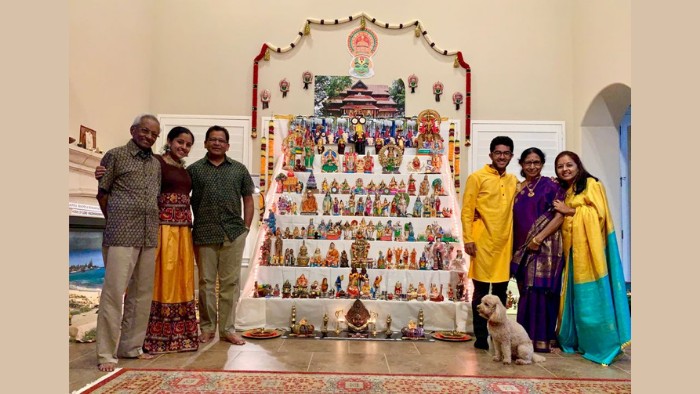One of the many festivities that take place during Navaratri in South India is the Dasara Doll Celebration. This is known as Golu or Gombe festival, Gombe meaning doll in Kannada. Dolls are arranged on a stepped platform with 3, 5, 7, 9, or 11 tiers. Different sets of dolls depicting a particular theme are arranged. The Dasara dolls are made in different regions of South India, especially in Tamil Nadu and Karnataka.
Pattada Gombe, a pair of wooden toys, are the main dolls in this festival. Also known as Marapacchi in Tamil, the toys represent husband and wife. They are decorated in silk and are given to a new bride by her parents to continue the tradition of this festival. In most houses, a specific theme is selected and dolls are arranged to weave a story.

CSP spoke to Smt Swathy Vasudevan, from Austin Texas, who also arranges dolls at her place circling around different themes every year. Her arrangement has garnered the attention of many non-Indians over the years.
“Navaratri golu has been a family tradition in the US for over 15 years. We like to present a thematic golu, which allows the opportunity to be creative and hone in on a certain topic or idea. Our entire family (Vasu, Rishab, and Sindhu) work together to set up the golu and implement the theme. It is an amazing and creative team effort, and it is something we look forward to and cherish. When my parents visit us, they also play a huge part in it,” said Swathy.
Some of her popular golu themes have been – Annapakshi, Artisans of India, Durge, “Tamaso Ma Jyotir Gamaya”, “Nammude Keralam”, “Kalamkari”, “Chinmaya Darshanam”, “Temples of Kerala”, “Devi Kshethra Anubhavam”, and this year it is “Panchalogam”.

Her neighbors and friends who are not from India are always amazed by their beautiful traditions. They see the effort that goes into the festivities, and greatly appreciate and adore the creative displays and arrangements. “They are happy to partake in the festivities and enjoy the traditional celebrations,” responded Swathy.
“I have met a couple of families from Japan, who have the tradition of doll display which is very similar to our Golu tradition. Some of my non-Indian friends who have visited our golus are inspired, and their kids arrange their Barbies, dollhouses, and toy kitchens to recreate our Golu.”
“Apart from some of us who feel comfortable in sharing and promoting our culture, I am not sure if enough has been done to share Navaratri or other traditions. It still remains mostly within the Indian community,” commented Swathy.
Many communities have shown immense interest in learning our traditions. Just as Indians rever the divine mother, many communities also pray and celebrate Her. Swathy has visited a Native American reserve in Arizona where she learned about the similarities in our culture and traditions. “Although it intrigues me a lot, I haven’t had the time and haven’t ventured out to research this further,” she said.

Swathy is also the founder of Sur Darbar, a not-for-profit organization based in Austin, Texas with a mission to promote Indian Classical Music, both Carnatic and Hindustani forms of music along with the culture and traditions associated with it. They offer a warm and welcoming platform for artists, budding performers, teachers, and students of music of all ages - both instrumental and vocal. Their mission is to create a rich and resourceful community for the artists, students, teachers, music rasikas, and enthusiastic audiences to connect, interact and support and promote each others’ art. “We began as a physical darbar in the southwest region of Austin but with the pandemic upon us have had to evolve to bring our events to you online,” Swathy told us.
Sur relates to music, and it literally means “singing or playing in good tune”. Darbar is a chamber/room where large gatherings happened in Indian history. The name was derived from the tradition of the royal period where musicians and artists performed in the presence of esteemed audiences.
Last year Sur Darbar released a series of videos called Devi Kshethra Anubhavam. In each episode, they took their audience on a virtual tour to various Devi Sthalas (places). Along with the tour, short stories about the presiding Devi were narrated, and songs were recited praising Her.
“This idea stemmed from the pandemic state that we were all in. Given that we could not travel or visit each other, the idea was to present a virtual experience. We never imagined that it would have the reach it did, and we were truly humbled by the positive response and feedback. Many have reached out to us from in and outside India stating they would like to visit some of these temples and experience the traditions in India – perhaps when it is safer to travel in the post-pandemic state,” expressed an elated Swathy.

As their mission states, Sur Darbar hopes to create a physical/virtual music community, a place filled with music, art, and Indian culture that comes alive with “in tune” performances/events by talented performers in the presence of knowledgeable audiences. Sur Darbar has strived to bring to audiences – classical music along with its’ history, art, and culture in varied formats such as music concerts, lecture demonstrations, talk shows, game shows, conversations, and more.




